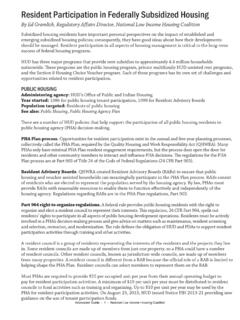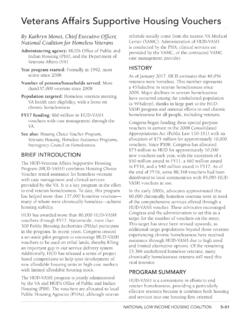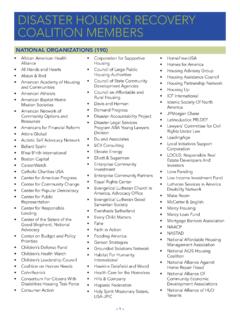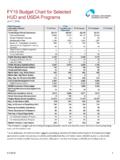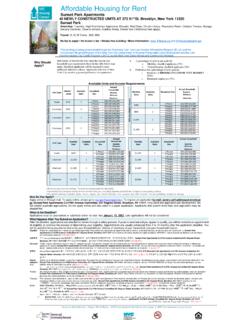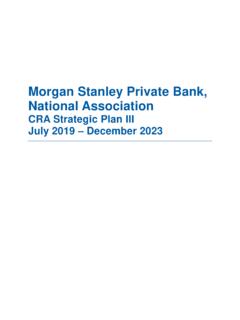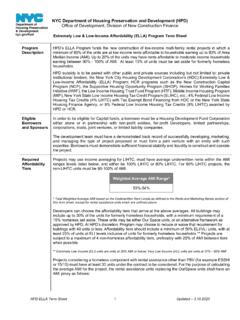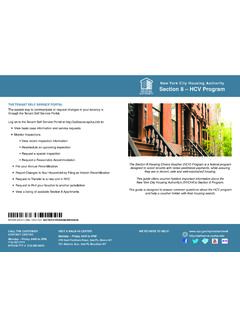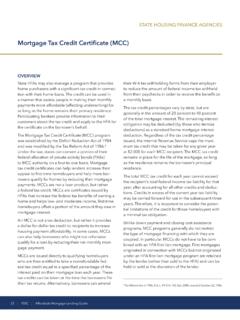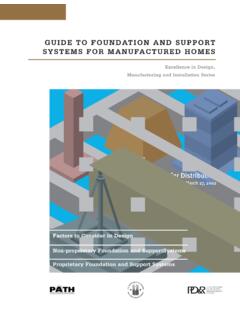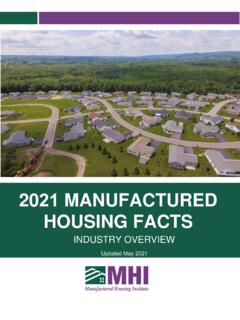Transcription of Tenant Protections and Emergency Rental Assistance during ...
1 JANUARY 2022 Tenant Protections AND Emergency Rental Assistance during AND BEYOND THE COVID-19 PANDEMICJADE VASQUEZ Project Coordinator for ERASEALAYNA CALABRO Policy AnalystKIM JOHNSON Senior Policy AnalystSARAH GALLAGHER ERASE Senior Project DirectorNATIONAL LOW INCOME housing COALITIONTABLE OF CONTENTSEXECUTIVE SUMMARY 1 RENTER Protections THAT SUPPORT ERA AND PREVENT EVICTIONS 3 STATE AND LOCAL EVICTION MORATORIUMS 4 PAUSES ON THE EVICTION PROCESS TO ALLOW FOR ERA PROCESSING 5 Requiring Landlords to Apply for ERA Before Filing for Eviction 5 Establishing Wait Periods and Safe Harbors for ERA Applicants 5 Issuing Eviction Stays 6 MANDATES THAT INCREASE ACCESS TO INFORMATION AND LIMIT FEES 7 Increasing Access to Information on Emergency Rental Assistance and the Eviction Process 7 Reducing or Limiting Late Fees 8 Landlord and Tenant Mediation 9 Establishing Right to Counsel and Expanding Access to Legal Aid 10 Protections THAT REDUCE DISCRIMINATION AND PROMOTE housing STABILITY 12 Source-of-Income Discrimination Laws 12 Prohibiting Landlords who Participate in ERA from Evicting Tenants in the Near-Term 13 Eviction Sealing and Expunging 14 CONCLUSION AND RECOMMENDATIONS 16 Tenant Protections AND Emergency Rental Assistance during AND BEYOND THE COVID-19 PANDEMIC 1 The longstanding housing affordability crisis in the United states entered a new
2 Stage of urgency in 2020, as the COVID-19 pandemic sparked an economic and public health crisis that threatened the housing stability and the lives of millions of renters. The COVID-19 pandemic made clear the inextricable link between housing and individual and public health, as millions of renters predominantly people of color struggled to remain safely and stably housed throughout the pandemic. Many low-income renters who had struggled to pay rent before the COVID-19 crisis were in an even more perilous position due to the loss of jobs, increased expenses, and resulting Rental arrears accrued during the pandemic. By January 2021, at least 9 million renter households1 were estimated to owe up to $50 billion in rent and utility arrears2 and were at high-risk of losing their homes.
3 To mitigate the spread of COVID-19 and keep people in their homes, the Centers for Disease Control and Prevention (CDC) issued a nationwide eviction moratorium, or a temporary halt in residential evictions for nonpayment of rent, in September 2020. In the months that followed, Congress passed two bills the Consolidated Appropriations Act of 2021 and the American Rescue Plan Act of 2021 that appropriated a total of $ billion in Emergency Rental Assistance (ERA) for states and localities to distribute to renters and landlords across the country. The public health Emergency and resulting historic aid to renters have fundamentally shifted the housing landscape in the United states . In addition to the federal moratorium and availability of Emergency Rental Assistance , state and local jurisdictions across the country have recognized the crucial role Tenant Protections play in preventing evictions and ensuring housing stability for the most marginalized households.
4 In 2021 alone, states and localities passed or implemented over 130 new laws or policies to protect tenants from eviction and keep them stably report provides a descriptive analysis of Tenant Protections and ERA-related policies that state and local governments enacted or implemented in 2021. The Tenant Protections included in this report are grouped into five categories: (1) state and local eviction moratoriums; (2) pauses on the eviction process to allow for ERA processing; (3) mandates that require landlords to apply for or share information on ERA before filing an eviction and that limit Tenant fees; (4) increases to Tenant representation during the eviction process; and (5) Protections that reduce discrimination and promote housing stability.
5 While the COVID-19 pandemic has highlighted the need for additional Tenant Protections , it has also presented opportunities to learn how existing Protections can be strengthened and expanded in the future. Emergency Rental Assistance and the short-term Tenant Protections tied to it will eventually expire, but long-term Tenant Protections , like source-of-income discrimination laws, right to counsel, and sealed eviction legislation, will outlast the pandemic and can guide housing advocates and policymakers looking to pass similar Protections in their own jurisdictions. 1 Consumer Financial Protection Bureau. (2021). housing insecurity and the COVID-19 Zandi, M. & Parrott, J. (2021). Averting an Eviction Crisis. Urban SUMMARYIn 2021 alone, states and localities passed or implemented over 130 new laws or policies to protect tenants from eviction and keep them stably housed.
6 2 NLIHC recommends the following actions at the state and local levels to protect tenants, prevent evictions, and support long term housing stability: State and local governments should continue to pass Tenant Protections in all stages of the eviction process to advance housing as a human right. states and localities must assess their Tenant -protection laws and programs to ensure maximum effectiveness in preventing evictions, from improving enforcement of source-of-income discrimination laws to adequately funding right-to-counsel programs. ERA programs, states , and local courts should develop collaborative partnerships to ensure the successful implementation and enforcement of Tenant Protections at all stages of the ERA and eviction process.
7 State and local courts should centralize eviction filing and outcome data for facilitating access to ERA to those in need, enforce existing Tenant Protections , and track housing stability outcomes for tenants who may have been evicted. Long-term federal Tenant Protections , such as source-of-income discrimination laws, just cause eviction standards, right to counsel, and sealed eviction legislation, are needed to ensure that all renters across all jurisdictions share a basic level of protection. A permanent program to provide Emergency Rental Assistance , such as that proposed in the Eviction Crisis Act introduced by Senators Michael Bennet (D-CO) and Rob Portman (R-OH), is needed to ensure housing stability for households that experience financial shocks after the pandemic ends.
8 3 Over the last year, NLIHC has tracked 30 states , including Puerto Rico and the District of Columbia, and 59 local jurisdictions that have implemented or passed either short-term or long-term Tenant Protections to protect marginalized renters and prevent a wave of evictions that would be catastrophic during a global pandemic. Short-term Protections are time-limited interventions that work within the eviction process to prevent, slow, or pause the process to allow Emergency Rental Assistance to be accessed before an eviction takes place. Short-term Protections include eviction-moratorium legislation, pauses on evictions while a Tenant s ERA application is under review, and efforts to coordinate the eviction process with Emergency Rental Assistance .
9 Long-term Protections are laws and policies intended to reduce discrimination and promote housing stability so that tenants face fewer barriers to housing in the long term. Such long-term Protections include right-to-counsel legislation, legal defense appropriations, source-of-income discrimination laws, and sealed eviction records legislation. Over the last year, such short- and long-term Protections were enacted via a combination of state legislation, local ordinances, executive and administrative orders, court orders, and ERA program policies and 2021, six executive and 16 court orders were signed, 78 state and local laws were passed, and 33 ERA programs enacted policies that provided additional Protections to Protections THAT SUPPORT ERA AND PREVENT EVICTIONSF igure 1.
10 New State and Local Tenant Protections (2021)Local ProtectionState Protection 4 When the eviction Protections in the Coronavirus Aid, Relief, and Economic Security (CARES) Act expired in August 2020, the CDC issued its own nationwide eviction moratorium, emphasizing the need to temporarily halt residential evictions to prevent the further spread of COVID 19. The federal eviction moratoriums extended vital Protections to renters at risk of eviction during the pandemic, helping to keep millions of people stably housed who otherwise would have been evicted. However, both the CARES ACT and the CDC moratoriums had significant shortcomings that prevented renters from making full use of the moratoriums Protections . For example, while the moratoriums gave many renters an important short-term reprieve, they did not prevent people from accruing housing debt.
